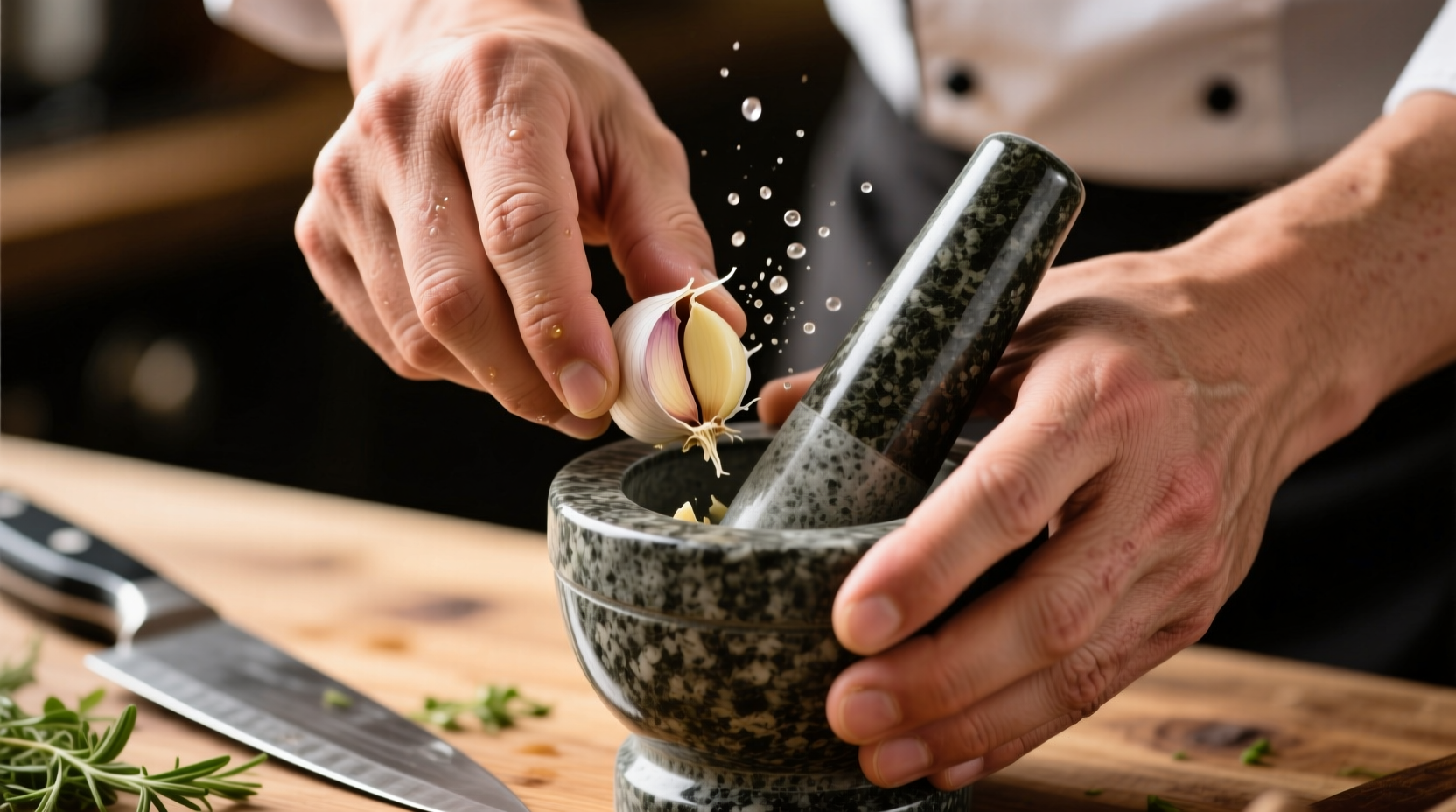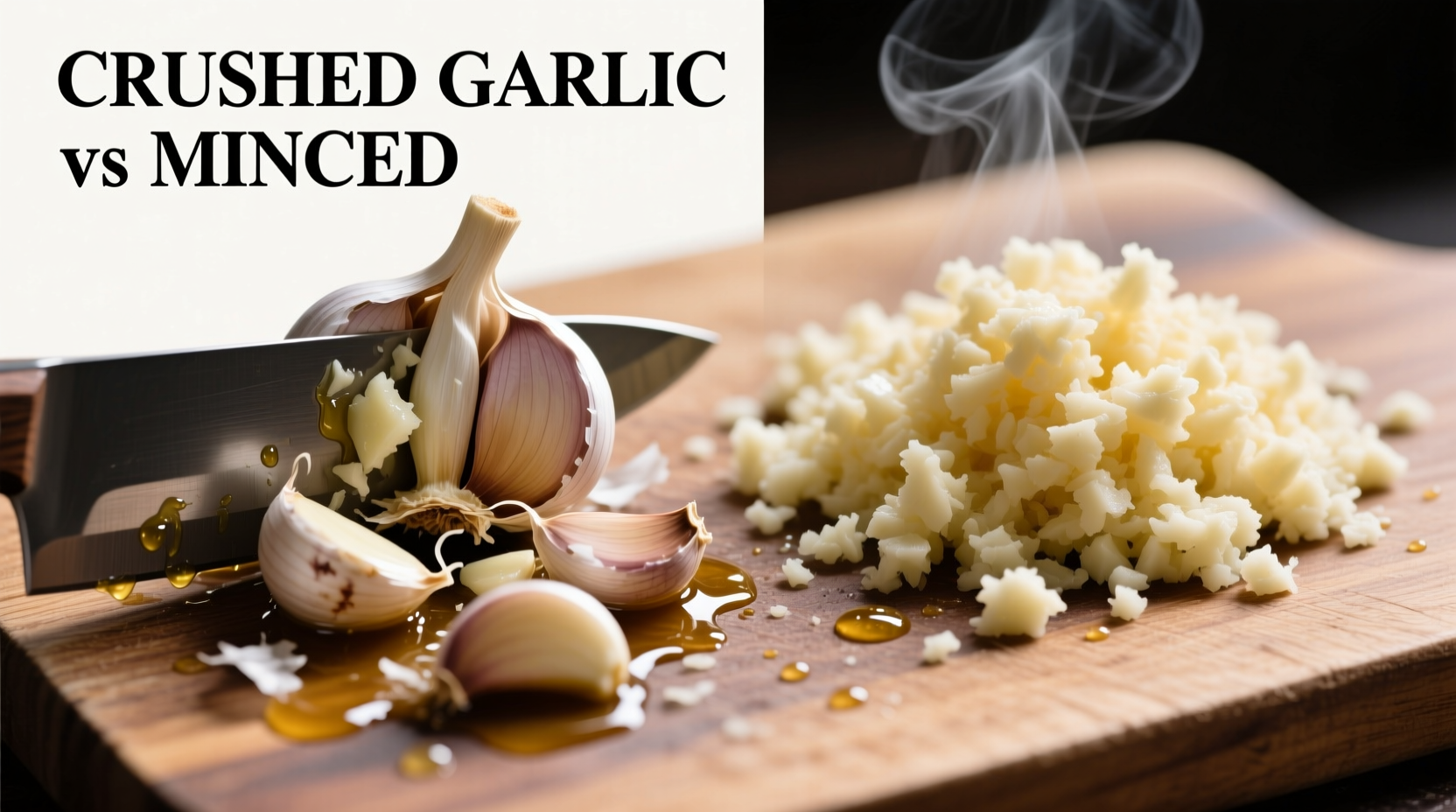Crushed garlic releases more intense, immediate flavor with a sharper bite, while minced garlic offers a more balanced, evenly distributed taste that mellow as it cooks. The difference comes down to cell disruption: crushing ruptures more garlic cells, releasing higher concentrations of allicin—the compound responsible for garlic's pungency.
Ever wonder why your pasta sauce tastes different when you change how you prepare garlic? The choice between crushed garlic versus minced isn't just about texture—it dramatically impacts flavor chemistry, cooking time, and final dish quality. Understanding these differences helps you control one of cooking's most powerful flavor elements.
Why Garlic Preparation Matters: The Science Behind Flavor
Garlic contains alliin, an odorless compound stored in separate cells from the enzyme alliinase. When you damage garlic cells through cutting or crushing, these components mix and create allicin—the volatile compound responsible for garlic's characteristic aroma and heat. The degree of cell disruption determines how much allicin forms and how quickly it breaks down into other flavor compounds.
| Preparation Method | Cell Disruption Level | Allicin Production | Peak Flavor Time | Flavor Duration |
|---|---|---|---|---|
| Crushed garlic | High (maximum cell rupture) | Immediate, high concentration | 1-2 minutes | Shorter (intense but fades faster) |
| Minced garlic | Moderate (partial cell rupture) | Gradual, moderate concentration | 5-7 minutes | Longer (more sustained flavor) |
| Garlic slices | Low (minimal cell disruption) | Slow, low concentration | 10+ minutes | Longest (mild, subtle flavor) |
According to research published in the Journal of Agricultural and Food Chemistry, crushing garlic releases approximately 3-4 times more allicin than mincing in the first two minutes after preparation. This scientific insight explains why crushed garlic delivers that immediate, pungent punch while minced garlic offers a more gradual flavor development.
Flavor Impact: When to Choose Crushed Garlic
Crushed garlic shines in dishes where you want an immediate, robust garlic presence:
- Quick-cooking preparations: Stir-fries, sautés, and pan sauces where cooking time is under 10 minutes
- Raw applications: Salad dressings, aiolis, and marinades where garlic won't cook further
- Italian classics: Traditional aglio e olio where garlic's sharp bite cuts through olive oil richness
- Garlic-forward dishes: Where garlic should be the star flavor rather than a background note
Professional chefs often crush garlic for Mediterranean dishes where the garlic flavor should remain prominent. As noted in USDA agricultural research, the higher surface area exposure from crushing creates more rapid flavor compound development—essential when working with short cooking windows.
When Minced Garlic Works Better
Minced garlic provides superior results when you need balanced, integrated garlic flavor:
- Long-simmered dishes: Stews, braises, and tomato sauces where garlic cooks for 30+ minutes
- Baking applications: Bread doughs, pizza crusts, and savory pastries
- Meat rubs and marinades: Where even distribution matters more than intensity
- Asian cuisine: Many Chinese and Thai dishes where garlic should complement rather than dominate
Minced garlic's smaller particle size distributes more evenly throughout dishes, preventing concentrated pockets of intense flavor. This makes it ideal for recipes where uniform garlic presence matters more than maximum pungency.

Practical Preparation Techniques
How you prepare garlic affects results as much as the method you choose:
Proper Crushing Method
- Peel clove and place flat side down on cutting board
- Place wide part of chef's knife over garlic
- Firmly press down with palm of hand (don't chop)
- Scrape up crushed garlic with knife edge
Effective Mincing Method
- Peel cloves and slice lengthwise first
- Cross-cut slices into fine pieces
- Rock knife repeatedly through garlic pile
- For finer mince, sprinkle with salt and crush with side of knife
Food science research from the American Chemical Society confirms that letting crushed garlic rest for 10 minutes before cooking maximizes allicin development, while minced garlic benefits from immediate cooking to prevent excessive enzymatic breakdown.
Common Mistakes to Avoid
Even experienced cooks make these garlic preparation errors:
- Using pre-minced garlic from jars: Contains preservatives that alter flavor chemistry and lacks fresh allicin development
- Adding garlic too early: Crushed garlic burns quickly—add during last 1-2 minutes of high-heat cooking
- Not adjusting cooking time: Minced garlic needs 30-60 seconds to mellow before adding liquids
- Over-processing: Turning minced garlic to paste creates bitter compounds through excessive oxidation
Storage Considerations
Prepared garlic has significantly shorter shelf life than whole cloves:
- Crushed garlic: Maximum 1 day refrigerated (loses potency rapidly)
- Minced garlic: Up to 3 days refrigerated in airtight container
- Never store prepared garlic in oil at room temperature (botulism risk)
- Freezing works better for minced than crushed garlic for long-term storage
According to food safety guidelines from the U.S. Food and Drug Administration, garlic-in-oil mixtures require refrigeration below 40°F (4°C) and should be consumed within 4 days to prevent potential bacterial growth.
Putting It All Together: Recipe Applications
Understanding these differences transforms your cooking results:
- Perfect pasta aglio e olio: Crush 4-5 cloves, sauté in olive oil for 60 seconds, then remove from heat before adding red pepper flakes and parsley
- Authentic chicken adobo: Mince 8-10 cloves for even distribution throughout the long simmering process
- Ideal garlic bread: Minced garlic mixed with butter distributes more evenly than crushed
- Balanced tomato sauce: Start with minced garlic in olive oil, cook 2 minutes before adding tomatoes
Mastering the crushed garlic versus minced distinction gives you precise control over one of cooking's most versatile flavor elements. Whether you're making a quick weeknight stir-fry or a slow-simmered Sunday gravy, choosing the right preparation method makes all the difference in your final dish.











 浙公网安备
33010002000092号
浙公网安备
33010002000092号 浙B2-20120091-4
浙B2-20120091-4